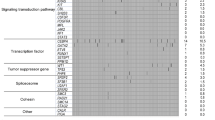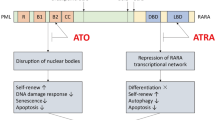Abstract
Purpose
APL patients have recurrent alterations in FLT3, WT1, NRAS and KRAS. Gene mutations have a strong potential for involvement in pathogenesis and may have potential effects on the clinical manifestations. Gene mutations may even be associated with early death (ED) in APL patients. However, there is little published information on mutations in APL patients and whether they are attributed to early death.
Methods
In this study, we retrospectively analyzed the clinical data and gene mutations of 134 de novo APL patients. We detected the gene mutations by next-generation sequencing (NGS) to investigate the genetic predictors of early death in APL patients. According to the number of gene mutations per patient, the 134 APL patients were divided into three groups. All patients received arsenic trioxide (ATO) alone as induction therapy. The clinical data and gene mutations were compared and analyzed.
Results
A total of 134 APL patients were involved in the study. The clinical data of sex, WBC, PT, and DD, UA, and LDH level were significantly different between the three groups (P = 0.000, P = 0.000, P = 0.009, P = 0.020, P = 0.030, P = 0.001 and P = 0.014, respectively). Meanwhile, among them, the Sanz risk stratification and early death rate were significantly different (P = 0.001). The early death rate was 10.4%, and the median time to early death was 6.6 days (range 2–15 days). For the next-generation sequencing, a mean of 1.28 ± 1.06 mutations per patient was detected (range: 0–5). The univariate and the multivariate regression analysis showed that age > 50[HR = 1.666, CI (1.027–2.702), P = 0.039], high WBC count [HR = 4.702, CI (1.026–21.543), P = 0.046] and low ALB levels [HR = 4.547, CI (1.088–18.995), P = 0.038] were independent risk factors for early death in APL patients. Furthermore, Kaplan–Meier survival analysis, univariate analysis, and the multivariate regression analysis showed that patients with multiple gene mutations [HR = 2.258, CI (1.115–4.571), P = 0.024], KRAS [HR = 5.136, CI (1.356–19.455), P = 0.016] and/or GATA2 [HR = 4.070, CI (1.287–12.877), P = 0.017] have a significantly higher early death rate.
Conclusion
The results of this investigation show that both molecular markers and clinical variables should be used as potential predictors for early death in APL patients. Our results suggested that age > 50, high WBC count, low ALB levels, and the presence of multiple gene mutations, KRAS and/or GATA2 at the time of diagnosis were independent risk factors for early death in APL patients. For these patients, clinicians should be more cautious during the course of induction treatment.




Similar content being viewed by others
Abbreviations
- APL:
-
Acute promyelocytic leukemia
- NGS:
-
Next-generation sequencing
- ATO:
-
Arsenic trioxide
- ATRA:
-
All-trans retinoic acid
- WBC:
-
White blood cell
- PLT:
-
Platelet
- PT:
-
Prothrombin time
- FIB:
-
Fibrinogen
- HGB:
-
Hemoglobin
- DD:
-
D-dimer
- AST:
-
Aspartate aminotransferase
- HCR:
-
Hematology complete remission
- ED:
-
Early death
- DS:
-
Differentiation syndrome
- ALB:
-
Albumin
- Cr:
-
Creatinine
- BUN:
-
Blood urea nitrogen
- UA:
-
Uric acid
- LDH:
-
Lactate dehydrogenase
References
Noguera NI, Catalano G, Banella C, et al. Acute promyelocytic leukemia: update on the mechanisms of leukemogenesis, resistance and on innovative treatment strategies. Cancers (Basel). 2019. https://doi.org/10.3390/cancers11101591.
Zhao J, Liang JW, Xue HL, et al. The genetics and clinical characteristics of children morphologically diagnosed as acute promyelocytic leukemia. Leukemia. 2019. https://doi.org/10.1038/s41375-018-0338-z.
Madan V, Shyamsunder P, Han L, et al. Comprehensive mutational analysis of primary and relapse acute promyelocytic leukemia. Leukemia. 2016. https://doi.org/10.1038/leu.2016.237.
Shen Y, Fu YK, Zhu YM, et al. Mutations of epigenetic modifier genes as a poor prognostic factor in acute promyelocytic leukemia under treatment with all-trans retinoic acid and arsenic trioxide. EBioMedicine. 2015. https://doi.org/10.1016/j.ebiom.2015.04.006.
Picharski GL, Andrade DP, Fabro ALMR, et al. The impact of flt3 gene mutations in acute promyelocytic leukemia: a Meta-Analysis. Cancers (Basel). 2019. https://doi.org/10.3390/cancers11091311.
Prieto-Conde MI, Jiménez C, García-Álvarez M, et al. Identification of relapse-associated gene mutations by next-generation sequencing in low-risk acute myeloid leukaemia patients. Br J Haematol. 2020. https://doi.org/10.1111/bjh.16420.
Iaccarino L, Ottone T, Alfonso V, et al. Mutational landscape of patients with acute promyelocytic leukemia at diagnosis and relapse. Am J Hematol. 2019. https://doi.org/10.1002/ajh.25573.
Cai P, Wu Q, Wang YM, et al. An effective early death scoring system for predicting early death risk in de novo acute promyelocytic leukemia. Leukemia Lymphoma. 2020. https://doi.org/10.1080/10428194.2020.1742910.
Lou YJ, Ma YF, Sun JN, et al. Effectivity of a modified Sanz risk model for early death prediction in patients with newly diagnosed acute promyelocytic leukemia. Ann Hematol. 2017;96:1793–800.
Hassan IB, Zaabi MRA, Alam A, et al. Characteristics features and factors influencing early death in acute promyelocytic leukemia; experience from United Arab Emirates (UAE). Int J Hematol. 2017. https://doi.org/10.1007/s12185-017-2211-7.
Steffenello-Durigon G, Bigolin A, Moraes ACR, et al. Follow-up and outcome of the twelve-year experience in adult patients with acute promyelocytic leukemia. Hematol Transfus Cell Ther. 2020. https://doi.org/10.1016/j.htct.2019.12.001.
Chien N, Varghese C, Green TN, et al. Treatment outcomes of patients with acute promyelocytic leukaemia between 2000 AND 2017, a retrospective, single centre experience. Leuk Res. 2020. https://doi.org/10.1016/j.leukres.2020.106358.
Ciftciler R, Haznedaroglu IC, Aksu S, et al. the factors affecting early death in newly diagnosed APL patients. Open Med (Wars). 2019. https://doi.org/10.1515/med-2019-0074.
Hou JX, Wang SY, Zhang YM, et al. Causes and prognostic factors for early death in patients with acute promyelocytic leukemia treated with single-agent arsenic trioxide. Ann Hematol. 2017. https://doi.org/10.1007/s00277-017-3130-7.
Jin B, Zhang YM, Hou WY, et al. Comparative analysis of causes and predictors of early death in elderly and young patients with acute promyelocytic leukemia treated with arsenic trioxide. J Cancer Res Clin Oncol. 2020. https://doi.org/10.1007/s00432-019-03076-x.
Zhou J, Meng R, Sui XH, et al. Effects of administration styles of arsenic trioxide on intracellular arsenic concentration, cell differentiation and apoptosis. Haematologica. 2005;90:1277–9.
Zhao H, Zhao Y, Zhang Y, et al. Difference in causes and prognostic factors of early death between cohorts with de novo and relapsed acute promyelocytic leukemia. Ann Hematol. 2018. https://doi.org/10.1007/s00277-017-3216-2.
Silva WFD Jr, Rosa LID, Marquez GL, et al. Real-life outcomes on acute promyelocytic leukemia in Brazil-early deaths are still a problem. Clin Lymphoma Myeloma Leuk. 2019. https://doi.org/10.1016/j.clml.2018.11.004.
Zhou J, Zhang Y, Li J, et al. Single-agent arsenic trioxide in the treatment of children with newly diagnosed acute promyelocytic leukemia. Blood. 2010. https://doi.org/10.1182/blood-2009-07-230805.
Zhang Y, Zhang Z, Li J, et al. Long-term efficacy and safety of arsenic trioxide for first-line treatment of elderly patients with newly diagnosed acute promyelocytic leukemia. Cancer. 2013. https://doi.org/10.1002/cncr.27650.
Xu F, Wang C, Yin C, et al. Analysis of early death in newly diagnosed acute promyelocytic leukemia patients. Medicine (Baltimore). 2017. https://doi.org/10.1097/MD.0000000000009324.
Yang S, Ma R, Yuan X, et al. Improved outcomes of all-trans-retinoic acid and arsenic trioxide plus idarubicin as a frontline treatment in adult patients with acute promyelocytic leukemia. Clin Lymphoma Myeloma Leuk. 2020. https://doi.org/10.1016/j.clml.2019.10.003.
Yoon JH, Kim HJ, Min GJ, et al. Progressive hyperleukocytosis is a relevant predictive marker for differentiation syndrome, early death, and subsequent relapse in acute promyelocytic leukemia. Sci Rep. 2019. https://doi.org/10.1038/s41598-019-47937-4.
Fasan A, Haferlach C, Perglerova K, et al. Molecular landscape of acute promyelocytic leukemia at diagnosis and relapse. Haematologica. 2017. https://doi.org/10.3324/haematol.2016.162206.
Rasekh EO, Elsayed GM, Madney Y, et al. Prognostic significance of bcr-1 and bcr-3 isoforms of PML-RARA and FLT3-ITD in patients with acute promyelocytic leukemia. Clin Lymphoma Myeloma Leuk. 2020. https://doi.org/10.1016/j.clml.2019.08.006.
Noguera NI, Breccia M, Divona M, et al. Alterations of the FLT3 gene in acute promyelocytic leukemia: association with diagnostic characteristics and analysis of clinical outcome in patients treated with the Italian AIDA protocol. Leukemia. 2002. https://doi.org/10.1038/sj.leu.2402723.
Esnault C, Rahmé R, Rice KL, et al. FLT3-ITD impedes retinoic acid, but not arsenic, responses in murine acute promyelocytic leukemias. Blood. 2019. https://doi.org/10.1182/blood-2018-07-866095.
Chan IT, Kutok JL, Williams IR, et al. Oncogenic K-ras cooperates with PML-RAR to induce an acute promyelocytic leukemia–like disease. Blood. 2006. https://doi.org/10.1182/blood-2006-04-015040.
Tsuzuki S, Towatari M, Saito H, et al. Potentiation of GATA-2 activity through interactions with the promyelocytic leukemia protein (PML) and the t(15;17)-generated PML-retinoic acid receptor alpha oncoprotein. Mol Cell Biol. 2000. https://doi.org/10.1128/mcb.20.17.6276-6286.2000.
Author information
Authors and Affiliations
Corresponding author
Additional information
Publisher's Note
Springer Nature remains neutral with regard to jurisdictional claims in published maps and institutional affiliations.
Rights and permissions
About this article
Cite this article
Chen, X., Fan, S., Zhao, Y. et al. Gene mutations in acute promyelocytic leukemia early death in patients treated with arsenic trioxide alone. Clin Transl Oncol 23, 2171–2180 (2021). https://doi.org/10.1007/s12094-021-02625-6
Received:
Accepted:
Published:
Issue Date:
DOI: https://doi.org/10.1007/s12094-021-02625-6




